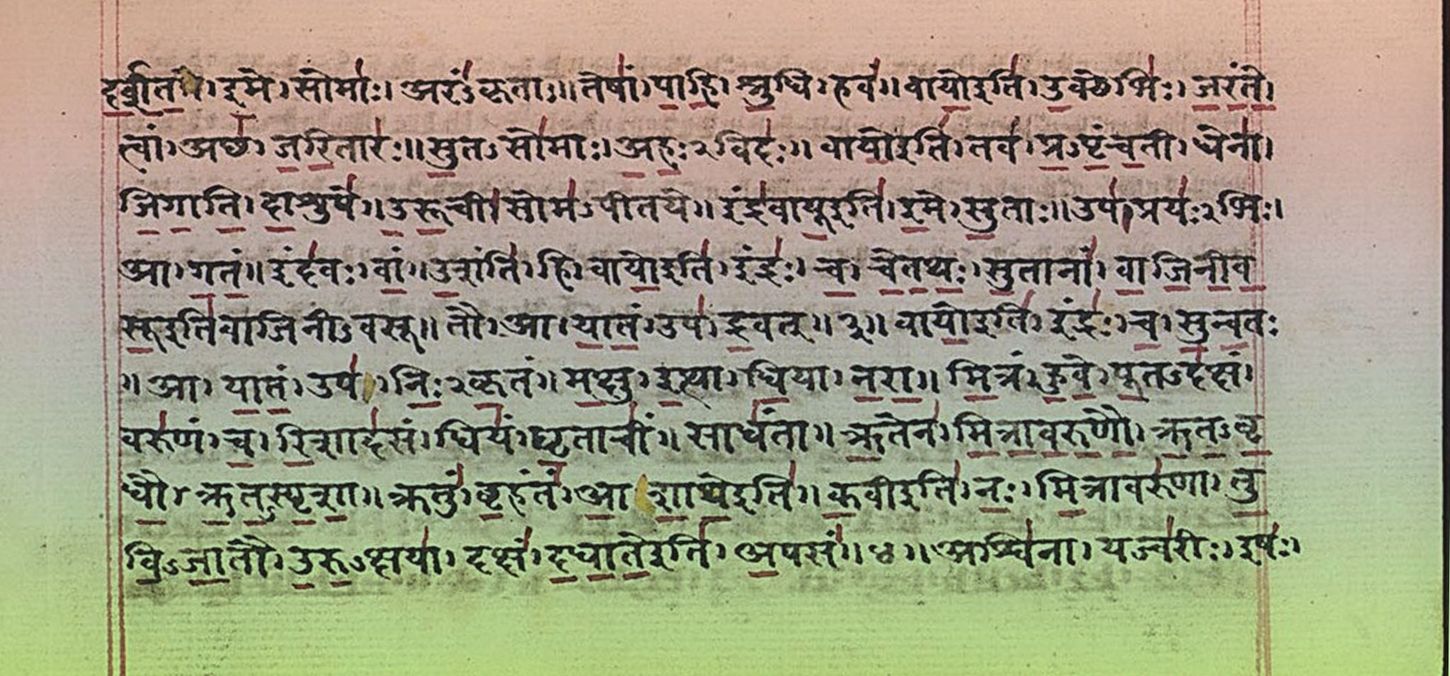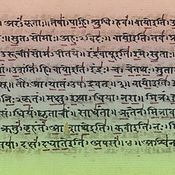
Um die [qualitative] Eigenschaft von Ruhe (nirodha-pariṇāma) in Deinem inneren Wahrnmungsraum (citta) zu kultivieren, wähle Eindrücke (saṁskāra) der Ruhe (nirodha) über solche der Zerstreuung (vutthāna).
Dr. Ronald Steiner - moderner Transfer
Das Überwinden (abhibhava | dv) von Prägungen der Aktivität (vyutthana | dv) und das Erscheinen (prādurbhāvau | nom du) von Prägungen der Ruhe (nirodha-saṁskāraoḥ | gen sg) [sind] die Formung eines Wahrnehmungsraumes (citta-anvayaḥ | nom sg) im Moment der Ruhe (nirodha-kṣaṇa | tp loc). [Dies ist] die Umwandlung zur Ruhe (nirodha-pariṇāmaḥ | nom sg) [der keimlosen Auflösungs-Erfahrung (nirbīja samādhi)].
Dr. Ronald Steiner - historisch-wörtlich
Vyāsa Bhāṣya 3.9
vyutthānasaṃskārāś cittadharmā na te pratyayātmakā iti pratyayanirodhe na niruddhā nirodhasaṃskārā api cittadharmās tayor abhibhavaprādurbhāvau vyutthānasaṃskārā hīyante nirodhasaṃskārā ādhīyante.
The subliminal-impressions of emergence are external-aspects (dharma) of mind-stuff; since they do not consist of presented ideas they are not restricted when presented-ideas are restricted. The subliminal-impressions of restriction are also external-aspects of mind-stuff. <When these two [states of mind-stuff] become visible or become invisibles [that is when]> the subliminal-impressions of emergence are withdrawing and the subliminal-impressions of restriction are being brought into place.
James Haughton Woods - 1914
Die Prägungen der Aktivität (vyutthānasaṃskārāḥ | nom pl) sind Charakteristiken des inneren Wahrnehmungsraumes (citta-dharmāḥ | nom pl); diese (te | nom pl) haben nicht (na) die Gestalt von Vorstellungen (pratyayātmakāḥ | nom pl) und kommen nicht (na) zum Stillstand (niruddhāḥ | nom pl), wenn die Vorstellungen (pratyayānām | gen pl) zum Stillstand kommen (nirodhe | loc sg); die Prägungen des Stillstands (nirodhasaṃskārāḥ | nom pl) sind auch (api) Charakteristiken des Geistes (citta- dharmāḥ | nom pl); wenn diese beiden (tayor | gen du) überwunden werden (abhibhavaprādurbhāvau | nom du), werden die Prägungen der Aktivität (vyutthānasaṃskārāḥ | nom pl) überwunden (hīyante | 3p pl pres) und die Prägungen des Stillstands (nirodhasaṃskārāḥ | nom pl) werden eingebracht (ādhīyante | 3p pl pres).
nirodhakṣaṇaṃ cittam anveti tad ekasya cittasya pratikṣaṇam idaṃ saṃskārānyathātvaṃ nirodhapariṇāmaḥ.
The period of restriction is inseparably connected with the mind-stuff. Accordingly the mutation of restriction is this periodic alteration of subliminal-impressions of a single mind-stuff,…
James Haughton Woods - 1914
Der Moment des Stillstands (nirodhakṣaṇam | nom sg) ist mit dem inneren Wahrnehmungsraum (cittam | nom sg) verbunden (anveti | 3p sg pres); und (tad | nom sg) die Transformation des Stillstands (nirodha-pariṇāmaḥ | nom sg) ist diese (idam | nom sg) Verschiedenheit (anyathātvam | nom sg) der Prägungen (saṃskārāṇām | gen pl) dieses einen (ekasya | gen sg) Geistes (cittasya | gen sg) in jedem Moment (pratikṣaṇam | acc sg).
tadā saṃskāraśeṣaṃ cittam iti nirodhasamādhau vyākhyātam. 3.9
… because then the mind-stuff has nothing but subliminal-impressions, as has been explained [i. 18] with reference to the concentration of restriction.
James Haughton Woods - 1914
Dann (tadā | adv) - in der Versenkung des Stillstands (nirodhasamādhau | loc sg) - besteht der innere Wahrnehmungsraum (cittam | nom sg) nur noch aus Prägungen (saṃskāra-śeṣam | nom sg), wie erklärt wurde (vyākhyātam | nom sg).
Erläuterungen zum Vyāsa Bhāṣya
Prägungen der Aktivität:- Sind Charakteristiken des Geistes;
- diese haben nicht die Gestalt von Vorstellungen
- sie kommen nicht zum Stillstand, wenn die Vorstellungen zum Stillstand kommen;
Prägungen des Stillstands:
- Sind auch Charakteristiken des Geistes;
Wenn die Prägung der Aktivität überwunden werden und zugleich die Prägungen des Stillstands eingebracht werden, dann ist dies mit dem Moment des Stillstands des inneren Wahrnehmungsraumes verbunden. Die Transformation des Stillstands ist also das Überschreiben der Prägungen von Aktivität zu den Prägungen von Stillstand. Diese Umwandlung geschieht fortlaufend im inneren Wahrnehmungsraum.
In der Auflösung (samādhi) des Stillstands jedoch besteht der Geist nur noch aus Prägungen des Stillstandes. Also nicht mehr aus dem konstanten Umwandeln von Prägungen der Aktivität in Prägungen des Stillstandes.
When there is a becoming invisible of the subliminal-impression of emergence 1 and a becoming visible of the subliminal-impression of restriction, the mutation of restriction is inseparably connected with mind-stuff in its period of restriction.
James Haughton Woods - 1914
| 1: | Reading abhibhavaprādurbhārāu. |
Die Überwindung des Zustandes des Wachseins und das Zutagetreten des Zustandes der Unterdrückung bilden den das Cittam im Augenblicke der Unterdrückung betreffenden Unterdrückungsakt.
Paul Deussen - 1908
Out of the two trains of self-reproductive thought, resulting from the Vyutthāna and the Nirodha, when the former is subdued and the latter is manifested and at that moment of manifestation, the internal organ (Citta) is concerned in both of the trains, then, such modification of the internal organ is the modification in the shape of Nirodha.
James R. Ballantyne - 1852
Aus der Prägung (saṁskārāt | abl sg) [entsteht] ein beruhigter Fluss (praśānta-vāhitā | nom sg) dieses (tasya | gen sg) [inneren Wahrnehmungsraumes (citta)].
Dr. Ronald Steiner - historisch-wörtlich
Vyāsa Bhāṣya zu 3.10
nirodhasaṃskārābhyāsapāṭavāpekṣā praśāntavāhitā cittasya bhavati.
By reason of the subliminal-impression of restriction, the peaceful flow of the mind-stuff requires dexterity in the application of the subliminal-impressions of restriction.
James Haughton Woods - 1914
Der ruhige Fluss (praśānta-vāhitā | nom sg) des inneren Wahrnehmungsraumes (cittasya | gen sg) entsteht (bhavati | 3p sg pres) im Hinblick auf geschickte Übung der Prägungen des Stillstands (nirodha-saṃskāra- ābhyāsa-pāṭava-apekṣā | nom sg).
tatsaṃskāramāndye vyutthānadharmiṇā saṃskāreṇa nirodhadharmasaṃskāro 'bhibhūyata iti. 3.10
When these 1 subliminal-impressions become weak, the subliminal-impression which has external aspects of restriction is overwhelmed by the subliminal- impression which has external aspects of emergence.
James Haughton Woods - 1914
| 1: | In the text as received, tat refers to nirodha. If the variant nābhibhūyate be accepted, tat must refer, as Vacaspati points out, to vyutthāna. |
Wenn diese Prägungen schwach werden (tat-saṃskāra-māndye | loc abs sg), wird die Prägung (saṃskāraḥ | nom sg) mit den Merkmalen der Aktivität (vyutthāna-dharmiṇā | ins sg) von der Prägung (saṃskāreṇa | ins sg) mit den Merkmalen des Stillstandes (nirodha-dharma | nom sg) überwältigt (abhibhūyate | 3p sg pres).
Erläuterungen zum Vyāsa Bhāṣya
Wenn man darin geübt ist, die Prägungen des Stillstands zu kultivieren, kann der Geist in der Meditation friedlich und ohne Störung (praśānta-vāhitā) fließen, d.h. ohne von Prägungen der Aktivität abgelenkt zu werden. Umgekehrt, wenn diese Prägungen des Stillstands geschwächt werden, werden sie von den Prägungen der Aktivität wieder überwältigt. Man kehrt also in den nicht ruhigen Zustand zurück.
Du wirst erleben, wie diese so kultivierte Ruhe zu einer Gewohnheit (saṁskāra) für Dich wird. Dein Leben wird zu einem ruhigen Fluss (praśānta-vāhitā).
Dr. Ronald Steiner - moderner Transfer
Für dieses [das Cittam] ergibt sich aus jenem Zustande [der Unterdrückung] in beruhigtes Dahinfließen.
Paul Deussen - 1908
A uniform flow (of modifications of the internal organ arises) from the (aforesaid) train of self-reproductive thought.
James R. Ballantyne - 1852
This 1 [mind-stuff] flows peacefully by reason of the subliminal-impression.
James Haughton Woods - 1914
| 1: | The sūtra is an instance of dharma-pariṇāma, as explained in the Comment on iii.13. |
Das Abnehmen (kṣaya) von Zerstreuung (sarvārthatā) und das Aufgehen (udayau | nom du) von Einpünktigkeit (ekāgratayoḥ | gen du) des Wahrnehmungsraumes (cittasya | gen sg) [ist] die Umwandlung zum Auflösungs-Zustand (samādhi-pariṇāmaḥ | nom sg).
Dr. Ronald Steiner - historisch-wörtlich
Vyāsa Bhāṣya zu 3.11
sarvārthatā cittadharmaḥ.
Dispersiveness 1 is an external-aspect of the mind-stuff.
James Haughton Woods - 1914
| 1: | See iv. 23. |
Die Zerstreuung (sarvārthatā | nom sg) ist eine Charakteristik des Geistes (citta-dharmaḥ | nom sg).
ekāgratāpi cittadharmaḥ.
Singleness-of-intent is an external-aspect of the mind-stuff.
James Haughton Woods - 1914
Das Auf-eins-Gerichtetsein (ekāgratā | nom sg) ist auch (api) eine Charakteristik des Geistes (citta-dharmaḥ | nom sg).
sarvārthatāyāḥ kṣayas tirobhāva ity arthaḥ.
The dwindling of dispersiveness means that it disappears;
James Haughton Woods - 1914
Die Vernichtung (kṣayaḥ | nom sg) der Zerstreuung (sarvārthatāyāḥ | gen sg) bedeutet (ity arthaḥ), dass sie verschwindet (tirobhāvaḥ | nom sg).
ekāgratāyā udaya āvirbhāva ity arthaḥ.
… the uprisal of singleness-of-intent means that it becomes apparent.
James Haughton Woods - 1914
Das Hervorkommen (udayaḥ | nom sg) des Auf-eines-Gerichtetseins (ekāgratāyāḥ | gen sg) bedeutet (ity arthaḥ), dass es erscheint (āvirbhāvaḥ | nom sg).
tayor dharmitvenānugataṃ cittaṃ, tad idaṃ cittam apāyopajanayoḥ svātmabhūtayor dharmayor anugataṃ samādhīyate sa cittasya samādhipariṇāmaḥ. 3.11
The mind-stuff is inseparably connected with both of these as the substance [in which they inhere]. This same mind-stuff being inseparably connected with these two external-aspects which belong to itself, the passing away [of the distributiveness] and the coming forth [of the singleness-of-intent], becomes concentrated. This is the mutation of concentration.
James Haughton Woods - 1914
Der Geist (cittam | nom sg) ist mit beiden (tayor | gen du) charakteristischen Merkmalen (dharmitvena | inst sg) verbunden (anugatam | nom sg); genau dieser Geist (tad idam cittam | nom sg) mit der schwindenden [Zerstreuung] (apāya | loc sg) und dem hervorkommenden [Auf-eins-Gerichtetsein] (upajanana | loc sg) Charakteristiken (dharmayoḥ | gen du) verbunden (anugatam | nom sg), die zu ihm gehören (svātma-bhūtayoḥ | gen du), kommt in den Zustand der Auflösung (samādhīyate | pres pass sg). Das (sa | nom sg) ist die Transformation der Auflösung (samādhi-pariṇāmaḥ | nom sg) des Geistes (cittasya | gen sg).
Erläuterungen zum Vyāsa Bhāṣya
Weitere Charakteristiken des inneren Wahrnehmungsraumes sind:
- Die Zerstreuung
- Das Auf-eins-Gerichtsein.
Der innere Wahrnehmungsraum ist beiden verbunden. Wenn die Zerstreuung schwindet und das Auf-eins-Gerichtetsein hervorkommt, dann ist das die Umwandlung des Geistes zum Auflösungs-Zustand.
Um Deinem Wahrnehmungsraum (citta) die [räumliche] Ausrichtung der Bündelung (samādhi-pariṇāma) zu schenken. Wähle Konzentration (ekāgratā) über Zerstreuung (sarvārthā).
Dr. Ronald Steiner - moderner Transfer
Die Vernichtung der Vielgeschäftigkeit des Cittam und das Hervortreten seiner Konzentration ist der Versenkungsakt.
Paul Deussen - 1908
Out of the two (properties) of the internal organ citta- which consists of sarvārthatā (that is its comprehension of several object) and ekāgratā (i.e., its intentness on a single point): (when) the first is utterly destroyed and the second is manifested– (at that time the connection of the internal organ with both of the properties or the state in which it exists as Dharmī i.e., endowed with the two properties) is the modification of the internal organ in the shape of Samādhi (meditation).
James R. Ballantyne - 1852
The 1 mutation of concentration is the dwindling of dispersiveness and the uprisal of singleness-of-intent belonging to the mind-stuff.
James Haughton Woods - 1914
| 1: | The sūtra is an instance of lakṣaṇa-pariṇāma, as explained in iii. 13. |
Dann schließlich (tataḥ punaḥ a) [treten] die beruhigende (śānta)b [Umwandlung zur Ruhe (nirodha-pariṇāma)] und die bündelnde (uditau | nom du)c [Umwandlung zur Bündelung (samādhi-pariṇāma)] gleichzeitig [auf]. [Dies ist] die Umwandlung zur ruhigen Sammlung (ekāgratā-pariṇāmaḥ | nom sg).
Dr. Ronald Steiner - historisch-wörtlich
| a: | In einigen Manuskripten fehlt tataḥ punaḥ, beispielswiese in der Version die Paul Deussen übersetzt. |
| b: | śānta(beruhigende) bezieht sich auf praśānta aus Satz 3.10 und damit auf Nirodha-Pariṇāma. |
| c: | Zwar steht hier udita (aufgehende, entstehende), doch wird uddita (gebündelt), von ud (auf, hoch) und dā (binden, fesseln), oft nachlässig nur udita geschrieben. So bezieht sich udaya auf 3.11 und damit auf Samādhi-Pariṇāma. |
Vyāsa Bhāṣya zu 3.12
samāhitacittasya pūrvapratyayaḥ śānta uttaras tatsadṛśa uditaḥ, samādhicittam ubhayor anugataṃ punas tathaivāsamādhibhreṣād iti.
The quiescent is a previous presented-idea of one whose mind-stuff is concentrated; the uprisen is a later presented-idea of the same kind as this [previous presented- idea]. But the mind-stuff of concentration is likewise inseparably connected with both. This is so until the breaking down of the concentration.
James Haughton Woods - 1914
Für jemanden, dessen Geist „versunken“ ist (samāhita-cittasya | gen sg), ist die vergangene Vorstellung (pūrva-pratyayaḥ | nom sg) ruhig (śānta | nom sg) und aufgestiegen ist eine spätere (uttaraḥ | nom sg), die genauso ist wie diese (tat-sadṛśa | nom sg), aber wieder (punaḥ | adv) der Geist im Auflösungs-Zustand (samādhi-cittam | nom sg) ist mit beiden (ubhayor | gen du) verbunden (anugatam | nom sg) … .
sa khalv ayaṃ dharmiṇaś cittasyaikāgratāpariṇāmaḥ. 3.12
This same mutation of singleness-in-intent belongs to the mind-stuff in which it resides (dharminaḥ).
James Haughton Woods - 1914
Genau diese (saḥ | nom sg) Transformation (pariṇāmaḥ | nom sg) des Auf-eins-Gerichtetseins (ekāgratā) des Geistes (cittasya | gen sg) ist dem Geist (dharmiṇaḥ | gen sg) zugehörig, in welchem es besteht (ayaṃ | nom sg).
Erläuterungen zum Vyāsa Bhāṣya
Situation:
- Die vergangene Vorstellung (pūrvapratyayaḥ) ist ruhig (śānta).
- Die aufgestiegenen ist eine spätere (uttaras,) die genauso ist wie diese (tat-sadṛśa) – also auch ruhig.
Dann ist der Geist im Auflösungszustand (samādhicittam) mit beiden (ubhayor) verbunden (anugataṃ).
Ruhige Sammlung (ekāgratā-pariṇāma) findest Du durch das gleichzeitige Auftreten beider Aspekte: Ruhe (śānta) und Bündelung (udita). Du tauchst in diese ruhige Sammlung ein indem Du sowohl die jeweils zugehörige beruhigende (nirodha-pariṇāma), wie auch die bündelnde Ausrichtung (samādhi-pariṇāma) zugleich erfährst.
Dr. Ronald Steiner - moderner Transfer
Then 1 again when the quiescent and the uprisen presented ideas are similar 2 [in respect of having a single object], the mind-stuff has a mutation single-in-intent.
James Haughton Woods - 1914
| 1: | According to the scheme of iii.13 this would appear to be an instance of avasthā-pariṇāma. |
| 2: | The Maṇiprabhã explains the word 'alike' (tulya) by adding ekaviṣayatvena. |
Der beruhigte [Unterdrückungsakt] und der erhabene [Versenkungsakt] des Cittam, wenn sie gleichstark eintreten, bilden den Konzentrationsakt.
Paul Deussen - 1908
(When) the two particular states or modifications (Pratyayhs) the one tranquil (Śānta) and the other risen (Udita) of the internal organ become equal, then its connection with both of the states is (its) modification in the shape of an intentness on a single point (Ekāgratā).
James R. Ballantyne - 1852



 Dr. Ronald Steiner
Dr. Ronald Steiner
 Laura von Ostrowski
Laura von Ostrowski

Nachrichten und Bewertungen